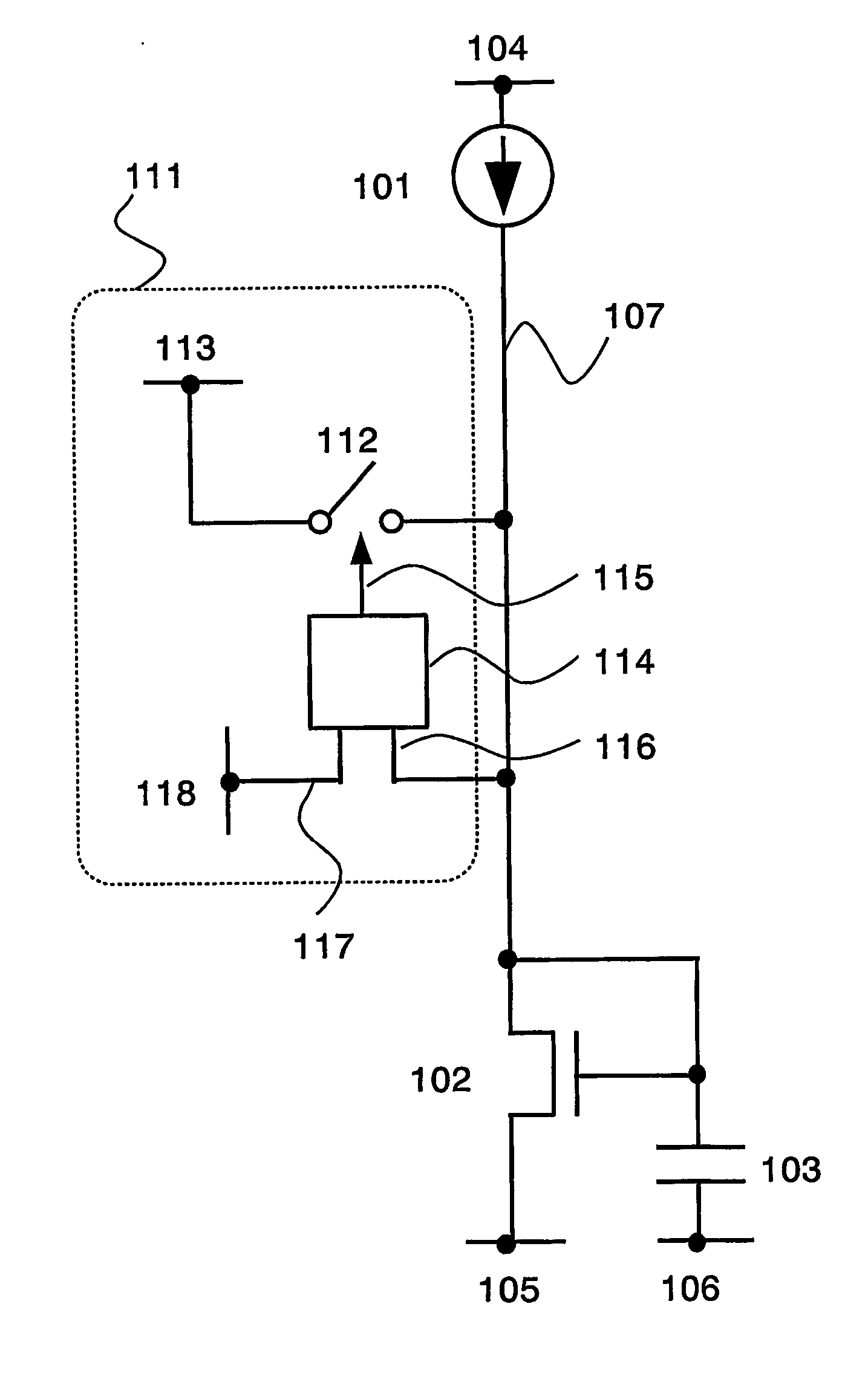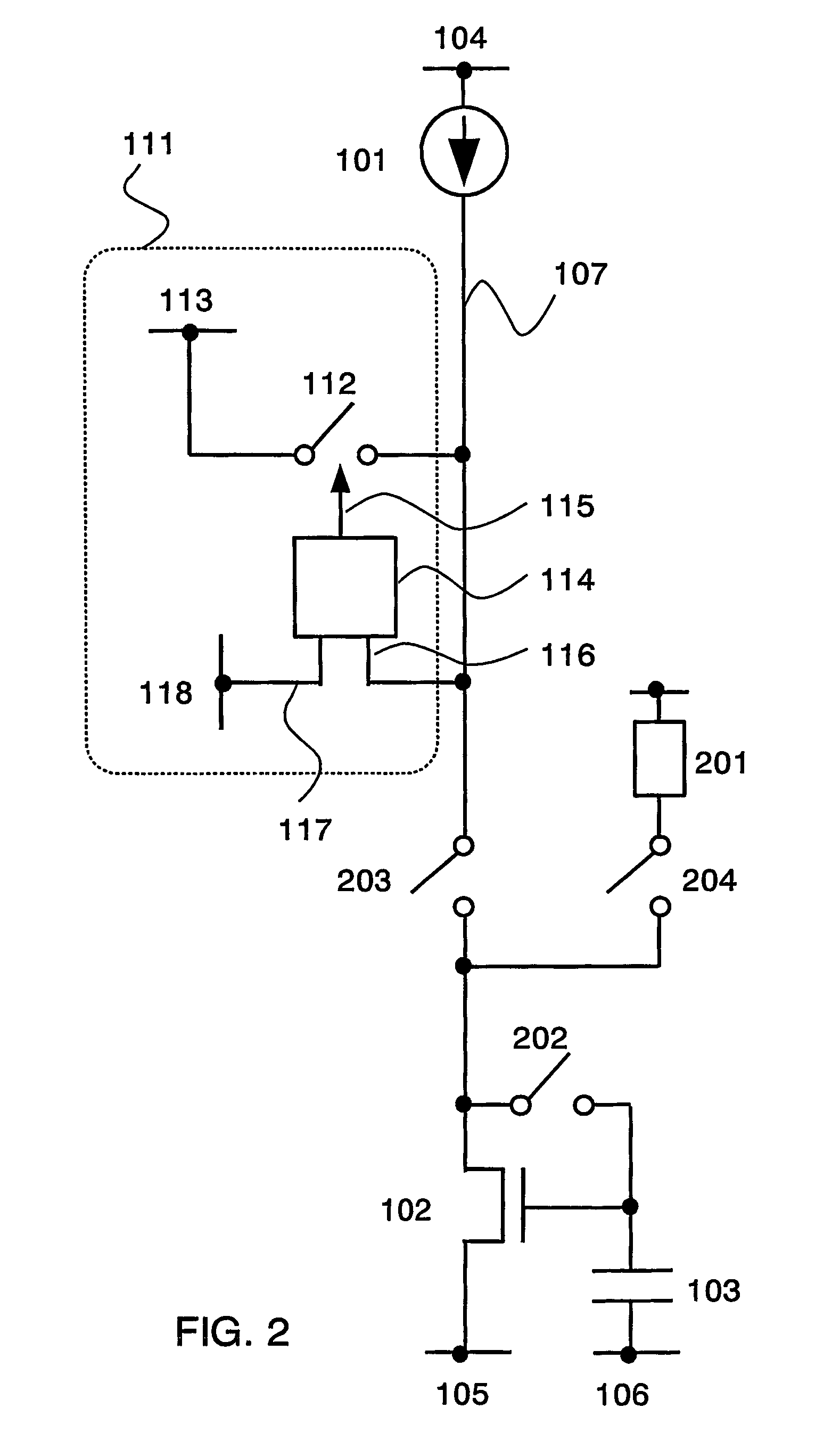Semiconductor device and driving method of the same
a technology of semiconductor devices and driving methods, applied in the direction of electronic switching, pulse techniques, instruments, etc., can solve the problems of source driver circuit problems, affecting and affecting the realization of large and high luminance displays, so as to reduce the effect of variations in transistor characteristics and improve the write speed of signals
- Summary
- Abstract
- Description
- Claims
- Application Information
AI Technical Summary
Benefits of technology
Problems solved by technology
Method used
Image
Examples
embodiment mode 1
[0095] According to the invention, a pixel is formed of an element which is capable of controlling a luminance according to a current value supplied to a light emitting element. Typically, an EL element can be applied. Among various known structures of an EL element, any element structure can be applied to the invention as long as it can control a luminance by a current value. That is, an EL element is formed by freely combining a light emitting layer, a charge transporting layer, and a charge injection layer, for which materials can be selected from a low molecular weight organic material, medium molecular weight organic material (organic light emitting material having no sublimation property and of which number of molecules is 20 or less, or a length of chain molecules is 10 μm or less) or a high molecular weight organic material. Further, the aforementioned material mixed or dispersed with non-organic material may be used.
[0096] First, a configuration based on the basic principl...
embodiment mode 2
[0116] FlG. 8 shows the case where the initial potential of the wiring 107 is higher than a potential obtained in the steady state as the most typical case. However, the initial potential of the wiring 107 is practically lower than the potential in the steady state in some cases. Now, the case of performing a precharge regardless of high and low of the initial potential is described.
[0117] First, FIG. 14 shows the case of disposing a plurality of precharge circuits 111a and 111b as a configuration example. It is assumed that a potential of a wiring 113a is higher than a potential of a wiring 113b. Therefore, the wiring 113a may be connected to a wiring 104 while the wiring 113b may be connected to a wiring 105.
[0118] In the case where the potential of the wiring 107 is lower, the precharge switch 112a is turned ON and a charge is supplied from the wiring 113a, thereby the potential of the wiring 107 rises rapidly. Otherwise, in the case where the potential of the wiring 107 is hig...
embodiment mode 3
[0133] Next, a specific example of a comparison control circuit is described. First, FIG. 22 shows the case where a comparison control circuit is configured by using an operational amplifier 2214. In the case of FIG. 22, a non-inverting terminal is connected to the wiring 118 and an inverting terminal is connected to the wiring 107. Therefore, in the case where the potential of the wiring 107 is low, a potential of the output terminal 115 becomes high. In the case where a potential of the wiring 113 is high, a precharge may be performed when the potential of the wiring 107 is low. In that case, the switch 112 may be turned ON.
[0134] Note that in the case where the potential of the output terminal 115 is to be high when the potential of the wiring 107 is high, for example, an inverter may be connected to an end of an output of the operational amplifier 2214 as shown in FIG. 23 to invert data or a connection of the non-inverting terminal and the inverting terminal of the operational ...
PUM
 Login to View More
Login to View More Abstract
Description
Claims
Application Information
 Login to View More
Login to View More - R&D
- Intellectual Property
- Life Sciences
- Materials
- Tech Scout
- Unparalleled Data Quality
- Higher Quality Content
- 60% Fewer Hallucinations
Browse by: Latest US Patents, China's latest patents, Technical Efficacy Thesaurus, Application Domain, Technology Topic, Popular Technical Reports.
© 2025 PatSnap. All rights reserved.Legal|Privacy policy|Modern Slavery Act Transparency Statement|Sitemap|About US| Contact US: help@patsnap.com



